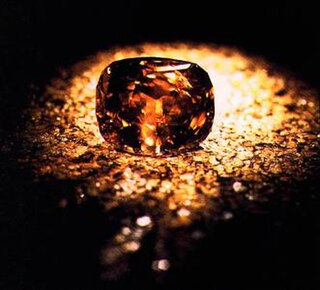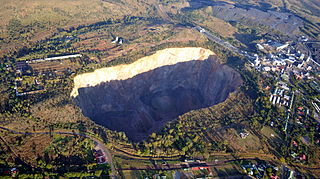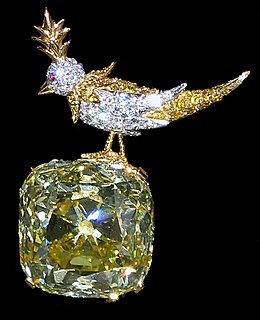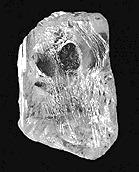
The Cullinan Diamond is the largest gem-quality rough diamond ever found, weighing 3,106.75 carats (621.35 g), discovered at the Premier No.2 mine in Cullinan, South Africa, on 26 January 1905. It was named after Thomas Cullinan, the owner of the mine. In April 1905, it was put on sale in London, but despite considerable interest, it was still unsold after two years. In 1907, the Transvaal Colony government bought the Cullinan and Prime Minister Louis Botha presented it to Edward VII, King of the United Kingdom, who had it cut by Joseph Asscher & Co. in Amsterdam.

The Golden Jubilee Diamond, a 545.67 carat brown diamond, is the largest cut and faceted diamond in the world. It outweighs the Cullinan I by 15.37 carats. The Golden Jubilee Diamond was discovered in 1985 at the Premier Mine, which is also the origin of the Cullinan diamond (1905) and other notables such as the Taylor–Burton (1966) and the Centenary (1986). Cullinan I, also known as the Great Star of Africa, had held the title of the largest cut and faceted diamond since 1908.

Cullinan is a small town in the Gauteng province of South Africa. It is located 30 km (19 mi) east of the city of Pretoria along the diamond route and is heavily reliant on tourism and the mine that dominates the skyline. The town is named after diamond magnate Sir Thomas Cullinan.
The Pink Star, formerly known as the Steinmetz Pink, is a diamond weighing 59.60 carat, rated in color as Fancy Vivid Pink by the Gemological Institute of America. The Pink Star was mined by De Beers in 1999 in South Africa, and weighed 132.5 carat in the rough. The Pink Star is the largest known diamond having been rated Vivid Pink. As a result of this exceptional rarity, the Beny Steinmetz Group called Steinmetz Diamonds took a cautious 20 months to cut the Pink. It was unveiled in Monaco on 29 May 2003 in a public ceremony.
The De Beers Centenary Diamond is, at 273.85 carats (54.770 g), the third-largest diamond to have been produced in the Premier Mine. Among top-color diamonds, only the Cullinan I and II are larger than the Centenary diamond. The Centenary Diamond is rated in color as grade D color by the Gemological Institute of America, which is the highest grade of colourless diamond and is internally and externally flawless. It was named the Centenary Diamond as it was presented in the rough for the Centennial Celebration of De Beers Consolidated Mines on 11 May 1988. The Centenary Diamond was unveiled in final form in May 1991.
The Great Chrysanthemum Diamond is a famous diamond measuring 104.15 carats with a pear-shaped modified brilliant cut, rated in colour as Fancy Orange-Brown and I1 clarity by the Gemological Institute of America. The Great Chrysanthemum is roughly the same size as the re-cut Kohinoor and almost three times the size of the Hope Diamond, The Great Chrysanthemum has the dimensions of 39.10 x 24.98 x 16.00 mm. and features 67 facets on the crown, 57 facets on the pavilion and 65 vertical facets along the girdle. The diamond, designed as a pendant, became the central focus of a necklace with 410 oval, pear-shaped, round and marquis diamonds.

The Excelsior Diamond is a gem-quality diamond, and was the largest known diamond in the world from the time of its discovery in 1893 until 1905, when the larger Cullinan Diamond was found. It was found on June 30, 1893 at the Jagersfontein Mine in South Africa, 130 kilometres south east of Kimberley whose fame as a diamond mining center always overshadowed that of Jagersfontein. It had a blue-white tint and weighed 971 old carats or 995.2 metric carats. The Excelsior rates as the fourth largest rough diamond of gem quality ever found. It was ultimately cut into ten stones weighing from 13 to 68 carats..

The Premier Mine is an underground diamond mine owned by Petra Diamonds in the town of Cullinan, 40 kilometres (25 mi) east of Pretoria, Gauteng Province, South Africa. Established in 1902, it was renamed the Cullinan Diamond Mine in November 2003 in celebration of its centenary. The mine rose to prominence in 1905, when the Cullinan Diamond – the largest rough diamond of gem quality ever found – was discovered there. The mine has produced over 750 stones that are greater than 100 carats (20 g) and more than a quarter of all the world's diamonds that are greater than 400 carats (80 g). It is also the only significant source of blue diamonds in the world.

Harry Winston was an American jeweler. He donated the Hope Diamond to the Smithsonian Institution in 1958 after owning it for a decade. He also traded the Portuguese Diamond to the Smithsonian in 1963 in exchange for 3,800 carats of small diamonds.

The Tiffany Yellow Diamond is one of the largest yellow diamonds ever discovered. Its carat weight was originally 287.42 carats in the rough when discovered in 1878 in the Kimberley mine in South Africa. It was cut into a cushion shape of 128.54 carats with 82 facets—24 more than a traditional round brilliant—to maximize its brilliance. The facet pattern features eight needle-like facets pointing outward from the culet (bottom) facet. Jewelry and diamond historian Herbert Tillander refers to this as a "stellar brilliant cut", and lists the gem in his book, Diamond Cuts in Historic Jewelry – 1381 to 1910 (1995), among other such diamonds: the Cullinan Diamond, the Koh-i-Noor, the Polar Star, the Wittelsbach, and others.
Gabriel S. "Gabi" Tolkowsky known for cutting the famous Centenary Diamond, is one of the world's most renowned diamond cutters. Known as the father of the modern round brilliant diamond cut. and the great nephew of Marcel Tolkowsky, he is the sixth generation in his family to become well known in the diamond cutting trade.

Petra Diamonds Ltd is a diamond mining group headquartered in Jersey. Petra own one of the world's most productive mines historically, the Cullinan Diamond Mine is famed for having produced the world's largest rough and polished diamond. The company is listed on the London Stock Exchange.

The 968.9-carat (193.78 g) Star of Sierra Leone diamond was discovered by miners on February 14, 1972, in the Diminco alluvial mines in the Koidu area of Sierra Leone. It ranks as the fourth-largest gem-quality diamond and the largest alluvial diamond ever discovered.

Brown diamonds are the most common color variety of natural diamonds. In most mines, brown diamonds account for 15% of production. The brown color makes them less attractive to some people as gemstones, and most are used for industrial purposes. However, improved marketing programs, especially in Australia and the United States, have resulted in brown diamonds becoming valued as gemstones and even referred to as chocolate diamonds.

The Eureka Diamond was the first diamond discovered in South Africa. It originally weighed 21.25 carats (4.250 g), and was later cut to a 10.73-carat (2.146 g) cushion-shaped brilliant, which is currently on display at the Mine Museum in Kimberley. The discovery of diamonds in South Africa led to the Kimberley Diamond Rush, and marked the beginning of the Mineral Revolution.
Graff is a British multinational jeweller based in London. It was founded by British jeweller Laurence Graff in 1960. A vertically integrated company, Graff operations comprise the design, manufacture and retail distribution of jewellery and watches.
The Woyie River Diamond was recovered on 6 January 1945 from the Woyie River near Koidu in eastern Sierra Leone. The uncut stone weighed 770 carats (154 g), and at that time it was the largest alluvial diamond ever found, and the third largest diamond discovered in Africa, after the Cullinan Diamond and the Excelsior Diamond. The alluvial Star of Sierra Leone, discovered at the Diminco mine in Sierra Leone in 1970, is larger at 968.9 carats (193.78 g) uncut.

Mouawad is a family-owned international company of Lebanese origin that makes and sells jewelry, objects of art, and luxury watches. The firm has headquarters in Geneva, Switzerland, with a Middle East headquarters at Jumeirah Lakes Towers in Dubai, as well as locations in Thailand, Malaysia, Singapore, and the United States. Founded in 1891 in Beirut, Lebanon by David Mouawad, the firm is now led by 4th generation co-guardians Fred Mouawad, Alain Mouawad and Pascal Mouawad.

Lesedi La Rona, formerly known in media as Karowe AK6 or as Quad 1 by the personnel at the mine, is the fourth-largest diamond ever found, and the third-largest of gem quality. It was found in the Karowe mine, in Botswana on 16 November 2015.













